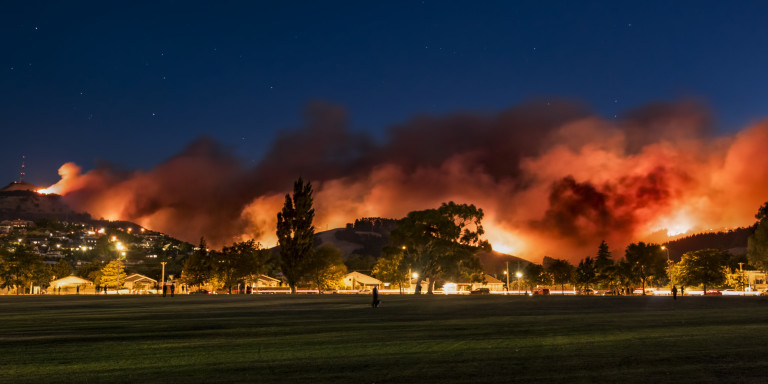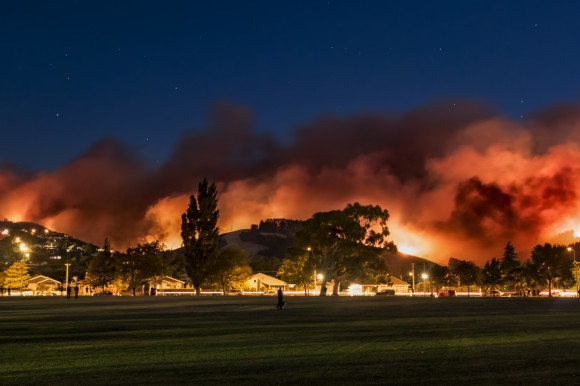When Wildfire Threatens
In a wildfire emergency, you may suddenly have to leave home for an extended period with little warning. The best thing you can do is prepare well and have your evacuation plan ready.
Use this space to note any additional information about your escape plan, i.e. who will assist
Smoke is poisonous and more deadly than flames.
If you breathe smoke for more than a few breaths it can kill you.
A house fire can kill you in less than three minutes.
Don't spend time trying to save possessions.
A closed door buys you time.
It slows down the spread of fire, giving you more time to get to safety.
People have died by going back into a fire.
Don't leave the meeting place to go back inside for any reason.


In a wildfire emergency, you may suddenly have to leave home for an extended period with little warning. The best thing you can do is prepare well and have your evacuation plan ready.
On this page
Help defend your home and property from wildfire with outdoor maintenance tips:
Learn the steps to protect your property - Checkitsalright.nz (external link)
List of low flammability plants - Checkitsalright.nz (external link)
In New Zealand, 98% of wildfires are started by people.
Our simple 3-step tool tells you whether it’s safe to use outdoor machinery or if you can light a fire based on the current fire season and fire danger risk. You’ll also find safety requirements and general guidance to avoid starting a wildfire by accident.
Use our 3-step Can I light a fire? tool - Checkitsalright.nz (external link)
Get involved in your community and get to know your neighbours so you can contact each other in an emergency, and so everyone understands the risks of wildfire in your area.
Identify a safe zone that is clear of vegetation in case you can’t evacuate and have to shelter in place.
Understanding the impacts of a wildfire can help keep you and your whānau safe. Have a chat with the people in your household and work out what you’ll do in this situation. We also encourage everyone to think about getting their workplace ready for a wildfire emergency.
Talk about the impacts — Getready.govt (external link)
You may have to evacuate your home or workplace because of a wildfire. Figure out what you and your family need if you have to stay away from home, and plan for what you require to get you through during this time. Consider things you need every day and what you would do if you didn’t have them?
Work out what supplies you need — Getready.govt (external link)
A household emergency plan lets everyone in your household know what to do in a wildfire and how to get ready.
Having a plan helps make actual emergency situations less stressful. Knowing your escape routes and a safe zone where you’ll meet up with your household is important. Ensure you also consider pets and livestock, including what would happen in the event that you are not at home.
Keep a map of your evacuation routes with your plan.
In a wildfire, a safe zone refers to places that are clear of vegetation and can provide adequate refuge from an approaching fire. They may have large areas of concrete or well-maintained short grass like on school grounds and sports fields, or large volumes of water, like a lake.
When planning your escape route, you won’t always know what direction the fire is coming from so it’s important to have more than one way out. Identify a safe zone that is clear of vegetation in case you can’t evacuate and you have to shelter in place (either on your property or within your community).
Make a plan — Getready.govt (external link)
Every household’s plan will be different because of where we live, who lives with us and who might need our help.
When making your household plan, remember to include everyone.
Think about the requirements of disabled people, older people, babies, young children, pets, and other animals.
Develop your plan including your livestock and pets so it’s matches your situation.
Tailor your plan — Getready.govt(external link)
Animals affected by fire - advice for livestock, lifestyle block, horse and pet owners - Mpi.govt.nz (external link)
Wildfires move quickly. If you can see the smoke or flames from a wildfire and you feel unsafe, don’t wait for an official warning to leave. Call 111 if your life or property is threatened, or you can’t evacuate on your own.
If you have time before you evacuate:
If there is time, you can also:
Emergency services will always aim to alert communities to an approaching fire, but there may not always be time to issue an official warning.
Watch out for firefighters still working in the area. Some roads may still be closed.
The situation can change quickly and get worse again. Listen to the radio or follow your Civil Defence Emergency Management Group online.
Watch out for burnt trees, hot embers on the ground and fallen powerlines.
If the power goes out, a battery-powered radio or your car radio can help you keep up to date with the latest news.
Check with your local Civil Defence Emergency Management Group to find out what local stations they recommend you should listen to during an emergency.
Emergency Mobile Alert (EMA) is a way of receiving information about emergencies in your area. If your life, health, or property is in imminent danger, Emergency Mobile Alerts can be sent to your mobile. You don’t need to sign up or download an App to receive them but be aware that not all phones can receive them, and they are only effective where there is mobile coverage.
For more information about the Emergency Mobile Alert, go to:
Emergency Mobile Alert — Get Ready — Emergency preparedness in New Zealand (external link)
Some councils use community alerting systems like GetsReady or free apps like Antenno to send text messages or email alerts to residents. Check with your local council or Civil Defence Emergency Management Group about what’s available in your area.
For local updates, follow your local Fire and Emergency District Facebook page, as well as your local council’s website and social media. Your Civil Defence Emergency Management Group website and social media channels may also be sharing information about wildfires.